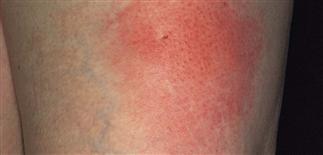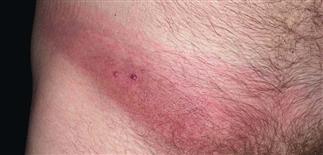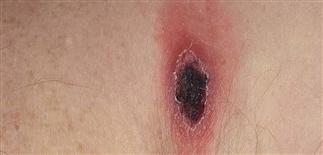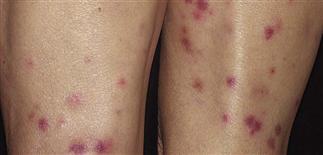94
Bee and wasp stings

Bee sting. Red to pink edematous hive-like plaque. Honey bees are the most common source of insect stings and can cause severe allergic reactions.

A large urticarial plaque began to occur minutes after the sting. The spot in the center is the sting site. This lesion was treated with an ice-cold wet compress to decrease swelling.

Severe local reaction to a sting with necrosis and ulcerations at the site of the bee sting. Necrosis is unusual. In this case, it is difficult to tell what type of insect caused the sting.

Edematous reaction to stings across the backs of the legs. Will last a few days before clearing up. Pruritus or tenderness is characteristic.
DESCRIPTION
Honey bees are the most common source of insect stings; can cause severe allergic reactions. Honey bee stinger separates from abdomen when stinging, remains embedded in vertebrate tissue. Stingers of other bees and wasps do not detach. Detached stinger is useful diagnostic feature for distinguishing honey bee stings.
HISTORY
• Initial sharp or painful sting lasts a few minutes, followed by moderate burning. Symptoms resolve in a few days. • Most reactions in children are mild. Children with deeper dermal reactions still have a benign course and are unlikely to have recurrent reactions. Severe reactions more common in adults. • Localized or systemic allergic reaction may develop. Patients sensitized by prior stings may develop large, local reactions, with edematous swelling forming hours after the sting and resolving in a few days. • Edema more prominent with head and neck stings. Toxic systemic reaction may develop hours after the sting. Vomiting, diarrhea, headache, fever, muscle spasm, loss of consciousness can occur. • Allergic anaphylactic reactions occur within minutes to hours after sting; involve itching, hives, shortness of breath, wheezing, nausea, abdominal cramps. Most fatal bee and wasp stings occur in hypersensitive persons older than 40 years who have received a single sting on head or neck. Death caused by respiratory dysfunction or anaphylaxis. Multiple stings can kill non-allergic people. Estimated median lethal dose of bee venom: 500–1500 stings.
PHYSICAL FINDINGS
• A hive or raised pink weal with a central pinpoint red punctum appears minutes after the sting and lasts for about 20 min. Angioedema may occur in the area, which is a localized reaction that appears thick, hard, and edematous over an area as large as 10–50 cm. • Main differential diagnostic concerns are bites from other insects.
TREATMENT
• Remove the stinger as fast as possible. The degree of envenomation does not differ if the stinger is scraped or pinched off. Delays of a few seconds in removing the stinger lead to greater venom delivery. • Localized non-allergic reactions are treated with ice and cool compresses; allergic reactions may also require antihistamines. • Treat severe generalized reactions with aqueous adrenaline (epinephrine) 1 : 1000 (0.3–0.5 mL s.c.), repeated at 20-min intervals if needed. If patient is hypotensive, an i.v. 1 : 10 000 dilution of adrenaline can be administered. Preloaded adrenaline syringe kits (e.g. EpiPen Auto-Injector, Anakit) are available. Can administer antihistamine (e.g. Benadryl) 25–50 mg orally or intramuscularly. • Venom immunotherapy highly effective for those with systemic reactions.







